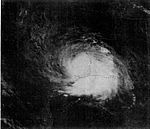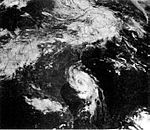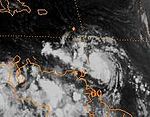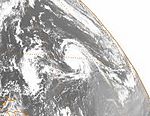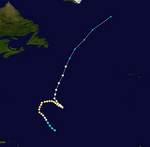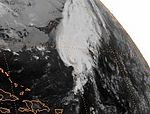1986 Atlantic hurricane season facts for kids
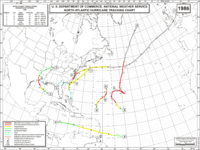 |
|
| First storm started: | June 5, 1986 |
| Last storm ended: | November 21, 1986 |
| Strongest storm: | Hurricane Earl - 978 mbar, 105 mph winds |
| Total storms: | 6 |
| Hurricanes: | 4 |
| Major hurricanes (Cat. 3+) | 0 |
| Cost of damage: | $3 billion (1986 USD) $5.2 billion (2005 USD) |
| People killed: | 9 direct |
The 1986 Atlantic hurricane season was a time when tropical storms and hurricanes formed in the Atlantic Ocean. It officially began on June 1 and ended on November 30, 1986. During this season, there were 6 named storms. Four of these storms grew strong enough to be called hurricanes.
Contents
Storms of 1986
Tropical Storm Andrew
| Tropical storm (SSHS) | |||
|---|---|---|---|
|
|||
| Duration | June 5 – June 8 | ||
| Intensity | 50 mph (85 km/h) (1-min), 999 mbar (hPa) | ||
Tropical Depression One started on June 5, just north of the Bahamas. It quickly became Tropical Storm Andrew the very next day. Andrew moved along the East Coast of the United States. It caused big waves and high surf along the beaches.
Luckily, there was only minor damage. Andrew faded away south of Cape Cod. Sadly, one person drowned off the North Carolina coast due to the high waves.
Hurricane Bonnie
| Category 1 hurricane (SSHS) | |||
|---|---|---|---|
|
|||
| Duration | June 23 – June 28 | ||
| Intensity | 85 mph (140 km/h) (1-min), 990 mbar (hPa) | ||
Tropical Depression Two formed south of the Louisiana coast on June 23. It quickly grew into a hurricane. Bonnie then made landfall on the upper Texas coast, near High Island.
Many streets in southeast Texas were flooded. Mobile homes were also damaged or destroyed. Sadly, three people lost their lives. Hurricane Bonnie caused about $2 million in damage in 1986.
Hurricane Charley
| Category 1 hurricane (SSHS) | |||
|---|---|---|---|
|
|||
| Duration | August 13 – August 18 | ||
| Intensity | 80 mph (130 km/h) (1-min), 987 mbar (hPa) | ||
A tropical depression started off the coast of Florida and moved inland. This storm then traveled across Florida. It exited the coast near Savannah, Georgia. There, it strengthened into Tropical Storm Charley.
Charley continued moving up the coastline. The storm became a hurricane before crossing the Outer Banks and the Delmarva Peninsula. Charley then moved out into the sea. It later changed into an extratropical storm in the northern Atlantic Ocean. This storm brought bad weather to the British Isles on August 25, causing significant damage there.
Tropical Storm Danielle
| Tropical storm (SSHS) | |||
|---|---|---|---|
|
|||
| Duration | September 7 – September 10 | ||
| Intensity | 60 mph (95 km/h) (1-min), 1000 mbar (hPa) | ||
On September 1, a tropical wave moved off the coast of Africa. It traveled west. This weather disturbance developed into a tropical depression on September 7. It then strengthened into a tropical storm later that same day.
Danielle reached its strongest point on September 8, with winds of 60 miles per hour. A special aircraft reported gusts that felt like hurricane-force winds. After passing through the Lesser Antilles, Danielle met strong winds high in the atmosphere. On September 10, it faded away in the central Caribbean Sea. The leftover parts of Danielle continued moving west. They eventually reformed in the Pacific Ocean as Tropical Storm Lester.
Hurricane Earl
| Category 2 hurricane (SSHS) | |||
|---|---|---|---|
|
|||
| Duration | September 10 – September 19 | ||
| Intensity | 105 mph (165 km/h) (1-min), 979 mbar (hPa) | ||
The strongest storm of the 1986 season began as a tropical wave off Africa on September 4. After moving across the tropical Atlantic Ocean, it strengthened into Tropical Depression Five on September 10. This was about 1240 miles (2000 km) east of Puerto Rico.
The depression quickly became a hurricane on September 11. Earl reached its strongest point on September 12. It was a Category 2 hurricane and traveled in a half-circle path. The hurricane weakened to a Category 1 storm on September 16. It then turned back the way it came. Earl later turned north and became an extratropical storm southeast of Newfoundland on September 19. At its strongest, Earl had steady winds of 105 mph (170 km/h). Its lowest central pressure was 979 mbar.
Hurricane Frances
| Category 1 hurricane (SSHS) | |||
|---|---|---|---|
|
|||
| Duration | November 18 – November 21 | ||
| Intensity | 85 mph (140 km/h) (1-min), 1000 mbar (hPa) | ||
Tropical Depression Six formed on November 18. It quickly strengthened into a tropical storm. The storm then curved northeast and became even stronger. It reached hurricane strength on November 20.
However, a high-pressure system to the north caused the storm to break apart. Frances was later destroyed by an extratropical low on November 21.
Storm Names
These are the names that were planned for use in the 1986 Atlantic hurricane season. In the Atlantic, these names are used again every six years. So, many of these names were also used in the 1980 and 1992 seasons. The names that were not used in 1986 are marked with gray.
|
|
|
Name Retirement
No storm names were removed from the list after the 1986 Atlantic hurricane season. Names are retired if a storm causes a lot of damage or deaths.
Related Pages
|
Tropical cyclones of the 1986 Atlantic hurricane season |
||||||||||||||||||||||||||
|
|
|||||||||||||||||||||||||
|
|
||||||||||||||||||||||||||
|
See also
 In Spanish: Temporada de huracanes en el Atlántico de 1986 para niños
In Spanish: Temporada de huracanes en el Atlántico de 1986 para niños




